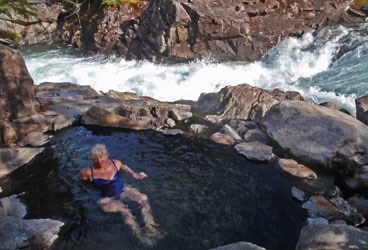
RH Baranoff 368
Some friends of mine from “the real” Alaska, that is those areas north of the panhandle, refer to Southeast Alaska disparagingly as North Seattle. They warned me about crowded waterways, gaudy tourist traps, and a paucity of wildlife. Apparently, once across the Gulf of Alaska, our adventure would be over. I promised to have a terrible time.
That pledge faltered when that lumbering grizzly on Admiralty Island took a keen interest in me. Or when that huge humpback whale surfaced so close to the Roger Henry that I could have scratched his back with our boathook.
While it is true that there are more towns, more signs of development, and more marine traffic, we are still enjoying lonely little anchorages, majestic scenery, and meeting interesting, and dare I say it, authentic Alaskans.
Admittedly, with five wedding-cake cruise ships lined up dockside, Juneau was busy. But it was a convenient port to fuel, provision, and catch up on our correspondence.
Even though inaccessible by road and far from the epicenter of Alaska’s burgeoning population, Juneau jealously holds on to its title of state capital. Perhaps this explains a little of the parochial competition. Several referendums have shown that the majority of Alaskans believe that practicality should trump history, and that the seat of government should be moved lock, stock, and barrel to Anchorage, which is 10 times the size. However, a local Juneau man smiled and told me, “It ain’t gonna happen.”
Steven Dahl, an enthusiastic sailor, graciously treated Diana and I to a rare night out (for us, anyway) in Juneau’s tourist district. We returned to the boat to find a note inviting us to the home of another sailing couple, Fred Hiltner and Cinda Stanek. I am still having flashbacks of that halibut casserole Cinda served, and must remember to send a note of apology for the quantity I consumed. I mentioned to Fred that I had recently broken my spinning rod and inquired where I might replace it. I awoke in the morning to a new rod lying on the aft deck with a note saying, “Enjoy your Alaskan fishing.”
Did I ever. The very next night in Taku Cove, not 30 miles from Juneau, I christened the rod by landing three Dolly Varden trout and a fat salmon while a jealous bear watched from the bushes.
An unusually long lasting high pressure kept the temperatures tropical and the skies blue as we explored southern Admiralty and eastern Baranoff islands.
Because our travel through the confined waters of the Inland Passage are limited to daylight hours, we are settling into a workable routine of setting sail as near to dawn as our discipline allows, making reasonable mileage through the day, and being anchored up in time to launch the dinghy and get a hike in at the new anchorage.
Once back onboard, as one of us prepares dinner, the other pores over the charts, tide book, pilot book, and cruising guide to determine the next day’s objective and, should winds or tides run afoul, a fall-back plan.
Eastern Baranoff is nothing short of majestic, with towering granite peaks, emerald forests, and waterfalls tumbling in slow motion towards the sea. Much as I hated leaving the wilds, I agreed to take Diana into Baranoff Hot Springs for a much-anticipated soak. The “town” consists of a free public jetty, and six houses, five of them empty. Although there are three enclosed hot tubs built above the jetty, we chose to hike into the woods to where the hot water emerges into two natural pools perched above a thundering cataract.
The water was hot, the air cool, and the setting sublime. We haven’t been this clean since the masochistic scrubs in the public bathhouses of Japan. Nevertheless, on the way back to the Roger Henry, Diana popped in to take another soak in the cedar hot tubs above the jetty.
When huge tides funnel into narrow channels, timing is everything. We arrived at Sergius Narrows in the Peril Strait at what the tidal prediction tables said was high water slack. True enough, but the fine print I failed to see on the chart warns that the tide inexplicably reverses two hours before high water. It was quite a ride.
By day’s end we were tied up to a marina berth in the historic town of Sitka, once the capital of Russian Alaska and center of the boom-and-bust sea otter pelt trade.
Today, this scenic town is known as the creative and artistic center of Southeast Alaska, and is home to many well-known carvers, artists, writers, photographers, and poets.
Speaking of poets, to describe for my “real” Alaskan friends the terrible time I am having here in South East, I’d like to employ the words of the famous Alaskan bard Robert Service.
“Oh in sorrow and woe, it’s easy to blow. It’s the hell served for breakfast that’s hard.”








